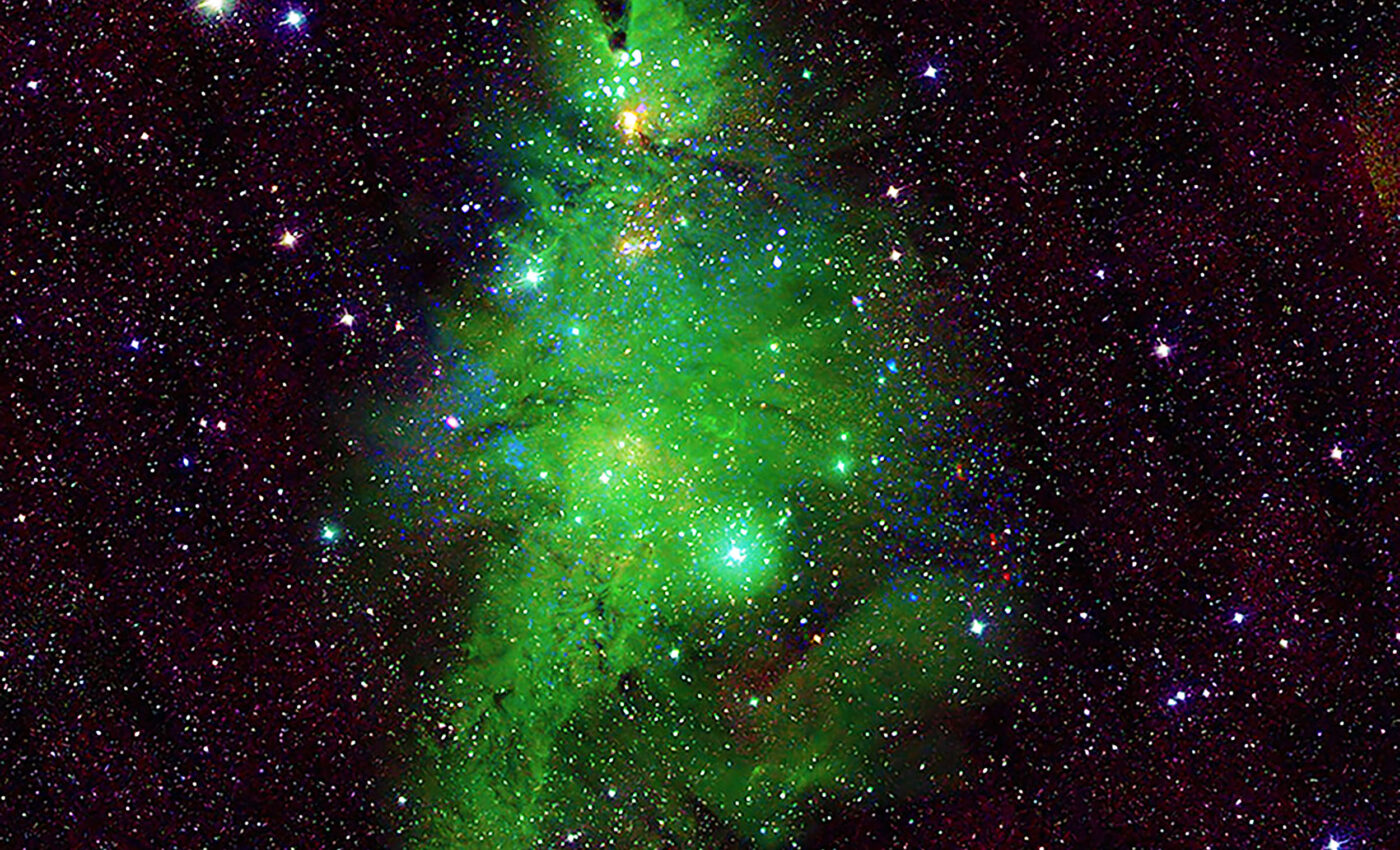
Cosmic "Christmas Tree Cluster" captured by NASA’s Chandra Observatory
The universe has its own festive display in the form of NGC 2264, also known as the “Christmas Tree Cluster” or the “Cosmic Christmas Tree.” This celestial marvel, situated approximately 2,500 light-years away in the Milky Way, is a cluster of young stars. These stars, varying in age from one to five million years, create a cosmic tableau reminiscent of a Christmas tree.
In this unique cosmic cluster, stars of various sizes coexist. Some are diminutive, with less than a tenth of the Sun’s mass, while others are more massive, boasting up to seven times the mass of our Sun. This diversity in size contributes to the cluster’s unique appearance.
Enhancing the “Cosmic Christmas Tree” image
The recent composite image of NGC 2264 enhances its resemblance to a holiday tree. This effect is achieved through specific choices in color and rotation.
In this vibrant depiction, young stars twinkle in hues of blue and white, their X-rays captured by NASA’s Chandra X-ray Observatory. These X-rays, which blink in the animated version of the image, add a dynamic quality to the view of the “Cosmic Christmas Tree.”
Complementing the Chandra data, optical observations from the National Science Foundation’s WIYN 0.9-meter telescope at Kitt Peak contribute to the image’s color palette. These observations highlight the nebula’s gas in green, akin to the pine needles of a Christmas tree.
Additionally, infrared data from the Two Micron All Sky Survey reveals foreground and background stars in a contrasting white.
To achieve the desired Christmas tree appearance, the image has been rotated about 160 degrees clockwise from the standard astronomical orientation. This rotation positions the tree’s apex towards the top of the image, enhancing its festive resemblance.
The nature of young stars in NGC 2264
The stars within NGC 2264 are characterized by their volatile nature. They experience intense flares in X-rays and other variations across different types of light.
The animated image, with its coordinated, blinking variations, is an artistic interpretation to emphasize the X-ray emitting stars and draw parallels to a twinkling Christmas tree. However, it’s important to note that in reality, these stellar variations are not synchronized.
These observed variations stem from various processes. Some are related to magnetic field activity, leading to powerful flares, akin to those seen on our Sun but on a much grander scale.
Additionally, these stars exhibit hot spots and dark regions on their surfaces, which become visible or hidden as the stars rotate. Changes in the obscuring gas’s thickness and the amount of material falling onto the stars from surrounding gas disks also contribute to these variations.
In summary, NGC 2264, the “Cosmic Christmas Tree,” presents a fascinating blend of astrophysical phenomena and natural artistry, reminding us of the universe’s ability to mirror Earth’s festive traditions in a grand cosmic scale.
More about Chandra and the “Cosmic Christmas Tree”
As mentioned above, the Chandra X-ray Observatory stands as a testament to human ingenuity in exploring the cosmos. Launched by NASA in 1999, it operates as a sophisticated space telescope designed to detect X-ray emissions from very hot regions of the universe, such as exploded stars, clusters of galaxies, and matter around black holes.
The mission and capabilities of Chandra
Chandra’s primary mission involves delving into the mysteries of the universe through X-ray eyes. It offers a unique perspective, enabling astronomers to observe phenomena such as supernovae, the regions surrounding black holes, and the hot gas permeating the vast clusters of galaxies. Its high resolution allows it to capture images fifty times finer than previous X-ray telescopes, revealing the universe in unprecedented detail.
Technological marvels of Chandra
Equipped with four very sensitive mirrors, Chandra can observe X-rays from sources billions of light-years away. The mirrors, nested inside each other, focus X-rays onto its detectors. This intricate design is a significant advancement in X-ray astronomy, allowing for clearer and more detailed observations than ever before, as seen above in the image of the “Cosmic Christmas Tree.”
Chandra’s contribution to astronomy
Over the years, Chandra has contributed significantly to our understanding of the cosmos. It has provided invaluable insights into the structure and evolution of the universe, helping to confirm the existence of dark matter and study the nature of dark energy. Chandra’s observations have also been crucial in studying the effects of black holes and mapping the distribution of dark matter in galaxy clusters.
A window to the x-ray universe
The Chandra X-ray Observatory continues to be a vital tool in astronomy, offering a unique window into the X-ray universe. Its discoveries have not only expanded our knowledge of the cosmos but have also challenged and refined existing theories about the nature of the universe.
As it continues its journey through space, Chandra remains a beacon of exploration, shedding light on the most mysterious corners of our universe.
—–
Like what you read? Subscribe to our newsletter for engaging articles, exclusive content, and the latest updates.
Check us out on EarthSnap, a free app brought to you by Eric Ralls and Earth.com.
—–













